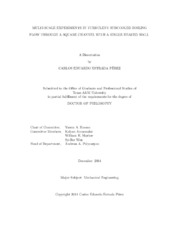| dc.contributor.advisor | Hassan, Yassin A. | |
| dc.creator | Estrada Perez, Carlos Eduardo | |
| dc.date.accessioned | 2015-05-15T16:19:39Z | |
| dc.date.available | 2016-12-01T06:36:06Z | |
| dc.date.created | 2014-12 | |
| dc.date.issued | 2014-12-12 | |
| dc.date.submitted | December 2014 | |
| dc.identifier.uri | https://hdl.handle.net/1969.1/154240 | |
| dc.description.abstract | In this work, visualization experimental techniques that provide whole-field and multi-scale measurements of the liquid turbulence parameters, liquid and heater wall temperatures, and gas phase local parameters, were used to study subcooled boiling flow through a square channel. The explored visualization techniques were: 1) Particle tracking velocimetry (PTV), which provides velocity measurements of the liquid phase, 2) High-speed shadowgraphy (HSS) which is used to study the dispersed phase dynamics. 3) Laser induced fluorescence thermometry (LIF) to measure whole-field liquid temperature fields. 4) High-speed infrared thermometry (IR-T), to study the impact of the boiling level on the heated wall temperature. A series of sensitivity studies were performed with which, knowledge for the optimal implementation of each technique was gained. Identification and quantification of uncertainties allowed to optimize the experimental conditions to achieve reliable and accurate liquid velocity measurements with the PTV technique. New procedures were designed to measure the average bubble velocity, bubble size, and void fractions. The single-nucleation site experiments provided optimal characteristics for the study of the bubble and liquid dynamics by means of PTV-shadowgraphy technique. This experiment simplified the quantification of the relationship that exist between the vapor and liquid parameters. From these results, new relationships and correlations are proposed to describe the near-wall liquid velocity behavior depending on local two-phase flow parameters. For the LIF thermometry, sensitivity studies were performed to evaluate the effects of excitation wavelength, dyes concentration ratios, solution pH, and selected emission bands on the temperature sensitivity of the two-color two-dye LIF thermometry technique. Temperature sensitivities of about 4% per °C were obtained, which is better than the traditionally used RhB-Rh60 solution which provides sensitivities of about 2% per °C. The present study is intended to lay down the experimental and data analysis foundations required to improve the understanding of subcooled flow boiling. This study also provides reliable and accurate experimental information for development and validation of two-phase flow computational models. | en |
| dc.format.mimetype | application/pdf | |
| dc.language.iso | en | |
| dc.subject | Subcooled Flow Boiling | en |
| dc.subject | Two-phase Flow | en |
| dc.subject | Particle Tracking Velocimetry (PTV) | en |
| dc.subject | Particle Image Velocimetry | en |
| dc.subject | Turbulence | en |
| dc.subject | Flow Visualization | en |
| dc.subject | Laser Induced Fluorescence (LIF). | en |
| dc.title | Multi-Scale Experiments in Turbulent Subcooled Boiling Flow Through a Square Channel with a Single Heated Wall | en |
| dc.type | Thesis | en |
| thesis.degree.department | Mechanical Engineering | en |
| thesis.degree.discipline | Mechanical Engineering | en |
| thesis.degree.grantor | Texas A & M University | en |
| thesis.degree.name | Doctor of Philosophy | en |
| thesis.degree.level | Doctoral | en |
| dc.contributor.committeeMember | Annamalai, Kalyan | |
| dc.contributor.committeeMember | Marlow, William H. | |
| dc.contributor.committeeMember | Wen, Sy-Bor | |
| dc.type.material | text | en |
| dc.date.updated | 2015-05-15T16:19:39Z | |
| local.embargo.terms | 2016-12-01 | |
| local.etdauthor.orcid | 0000-0002-5030-7479 | |


